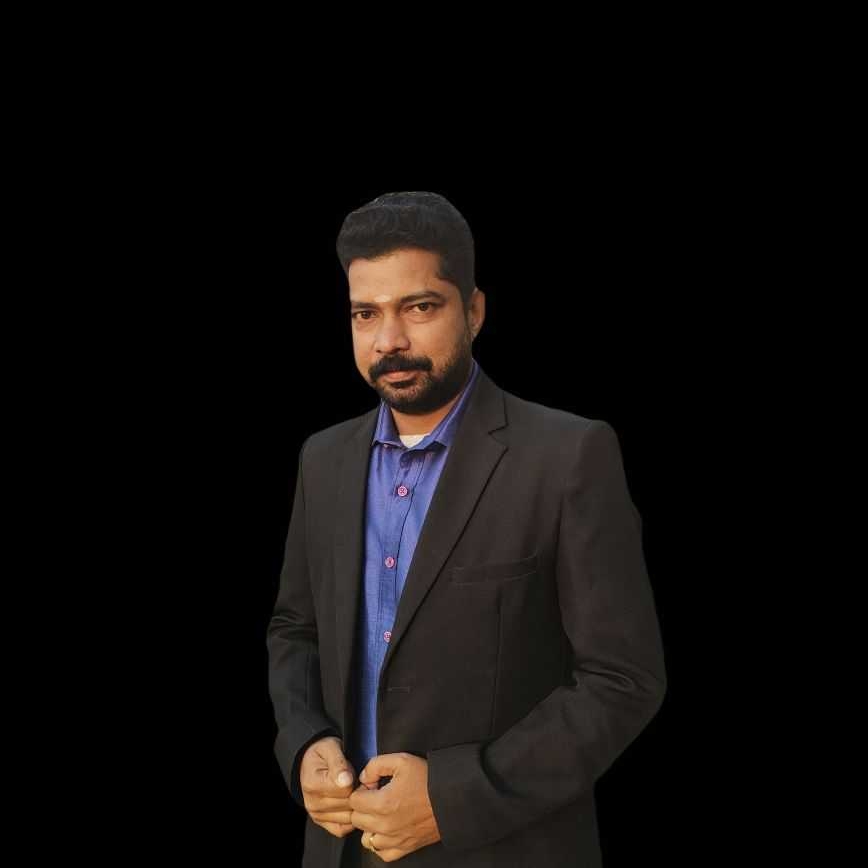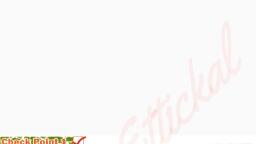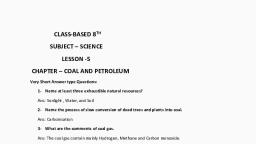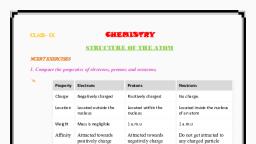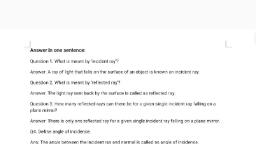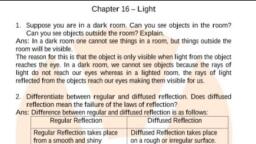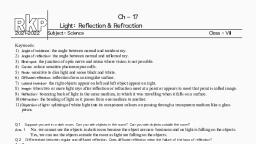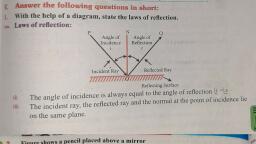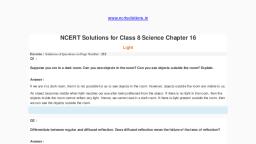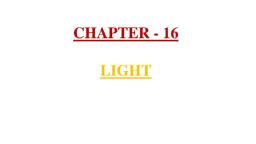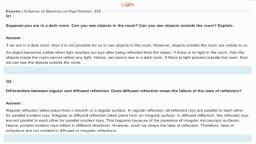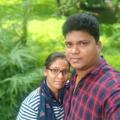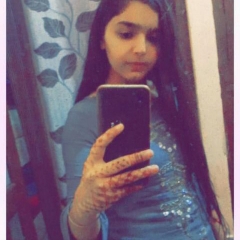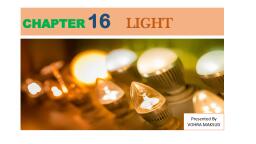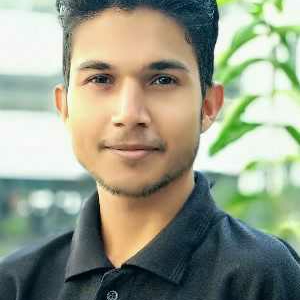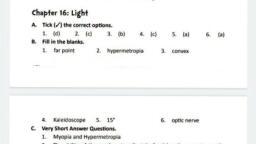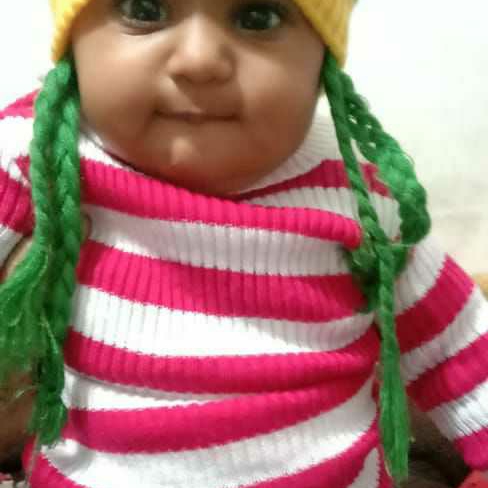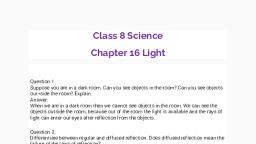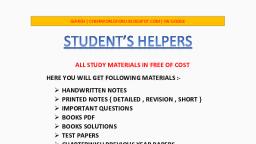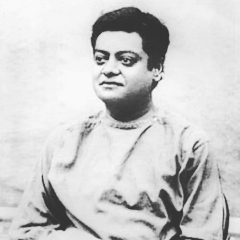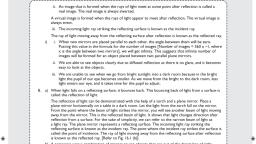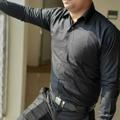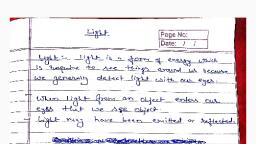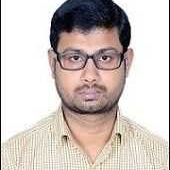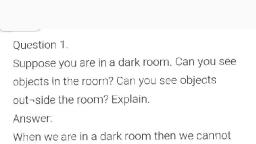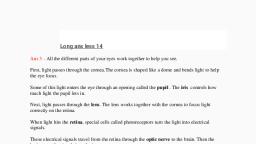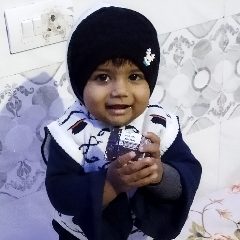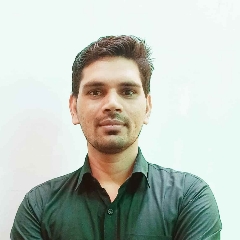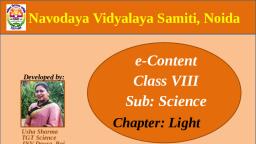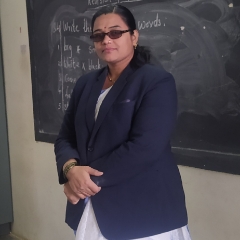Page 1 :
NAV JEEVAN MISSION SCHOOL, DEORIA, SCIENCE, , CLASS:VIII, , Text Book Name: Science Booster, LESSON 16: LIGHT, Short Answer Type Questions, 1. What are luminous and illuminated objects?, Ans:- The objects which shine by reflecting the light falling on them are called, illuminated objects., Eg:- Moon, The objects which Shine by giving their own light are called luminous objects., Eg:- Sun, 2. What are the laws of reflection of light?, Ans:- The laws of reflection of light are: When a ray of light falls on a plane smooth surface, it is reflected in the, same medium in such a way that the angle of incidence is equal to the angle, of reflection., The incident ray, the reflected ray and the normal always lie in the same, plane., 3. What is the difference between regular and irregular reflections of light?, Ans:Regular Reflection, When a beam of parallel rays of, light falls on a smooth and highly, , Irregular Reflection, When a beam of parallel rays of, light falls on a rough and uneven
Page 2 :
polished surface, almost entire, light gets reflected in the same, medium in a definite direction., This kind of reflection is called, regular reflection, Regular reflection leads to the, formation of clear image, , surface the light gets reflected in, different directions i.e., light rays, do not follow uniformity of, direction. This kind of reflection, is known as irregular or diffused, reflection, Irregular reflection leads to the, formation no image or blurred, image, , 4. What is dispersion of light?, Ans:- The splitting of white light into its seven colours after passing through a, prism is called dispersion of light., 5. What is myopia? How can it be corrected?, Ans:- Inability to see the distant objects clearly but ability to see the nearby, objects clearly is known as myopia or nearsightedness. This defect can be, corrected by using spectacles with concave lenses., Long Answer Type quesTions, , 1. What are the characteristics of light?, Ans:- The characteristics of light are: Light is a form of energy, Light is one of the fastest travelling forms of energy. It travels with a speed, of 3,00,000 kilometres per second in vacuum and almost with same speed in, air., Light needs no medium to travel i.e., it can travel in vacuum also., Light travels in straight line., No objects are visible in the absence of light.
Page 3 :
Light, as it comes from sun, consists of seven different colours, namely,, Violet, Indigo, Blue, Green, Yellow, Orange and Red. The sequence of, this colour band is known as VIBGYOR., When light falls on an opaque surface, it is reflected back, 2. Describe an experiment with diagram to verify the laws of reflection., Ans:- Place a white sheet of paper on a drawing board. Take a plane mirror, put it, vertically and draw a line MN along the margin of the mirror. Fix two pins A and, B at a gap of a few centimetres apart. They should appear in one line in the mirror., Now, by looking at the reflection of these two pins, fix two pins and on the other, side in such a way that images of all four pins appear in a straight line. Remove the, pins and draw a straight line along the path of AB and CD. The point where these, two lines meet mark it as O. Draw a perpendicular OR. This is called normal. The, angle formed by the incident ray (OP) and the normal is called angle of incidence, (i) and angle formed by the normal and reflected ray (OQ) is called angle of, reflection (r)., The equal measures of the angle of incidence and angle of reflection verify, the first law of reflection., The fact that we could trace and draw the incident ray, the normal and the, reflected ray on the same sheet of paper, verifies the second law of reflection
Page 4 :
3. What is a periscope? Describe its working., Ans:- A periscope is an example of multiple reflections which is of a great, practical utility. It is a rectangular tube, bent twice at an angle of 90° at its two, ends. In it, two plane mirrors are fitted at an angle of 45 0. This is used to detect, submarines or other objects at different heights from that of the viewer. The rays of, light travelling from the object to be seen, fall on the first mirror, from there they, are reflected and sent to the second mirror. The reflected light from the second, mirror is received by the eyes of the observer, who is able to see the object., 4. Describe the working of human eye., Ans:-, , The reflected light from an object enters the eye through cornea. Its amount is, controlled by the iris and the pupil. This light passes through the aqueous humour,, the eye lens and the vitreous humour in such a manner that an inverted image of, the object is formed at the retina. The photoreceptors in the retina detect the, brightness and the colours of the object. The message of the image formed at, retina is picked up by the optic nerve and take to the brain, so that we can actually, see. The optic nerve is a bundle of nerves which collects the visual signals from the, retina, invert it on the way and transmit it to the brain, for us to see the erect object., 5. List a few ways to take care of the eye., Ans:- To keep the eyes healthy, one should follow the following steps: The eyes should be washed every day with fresh and clean water at normal, temperature.
Page 5 :
Never rub the eyes., In case of dust particles get into the eyes, splash a lot of dean and cold water, into the eyes so as to wash away the dust., Never look at very bright sources of light like the sun or a welding spark, directly., Do not read or write in dim or very bright light and also in a moving vehicle., The minimum distance at which a normal human eye can read or see without, any strain, is 25 cm. This distance is known as the least distance for distinct, vision. Always keep your books or notebooks at a distance of distinct vision, (25 cm) from the eyes., The eyes need vitamin A for their proper functioning. Therefore, include, different sources of vitamin A into your diet., Avoid wearing contact lenses for more than 12 hours at a stretch., If allergic to sunlight, wear ultraviolet protective sunglasses., Visit an optometrist every year, they can diagnose problems that may be, fixed with glasses or surgery., 6. Study the given figure and answer the questions., , (a) Label the parts 1-5., Ans:- 1. Lens, 2. Pupil, 3. Iris
Page 6 :
4. Retina, 5. Blind spot, (b) Which part forms the image of an object?, Ans:- Lens, (C) Where is the image formed in human eye?, Ans:- Retina, (d) Where does the light enter the eye?, Ans:- Cornea, (e) Why is the part 5 called so?, Ans:- Blind spot is called so because the image formed at this point is not sensed, by the eye.
